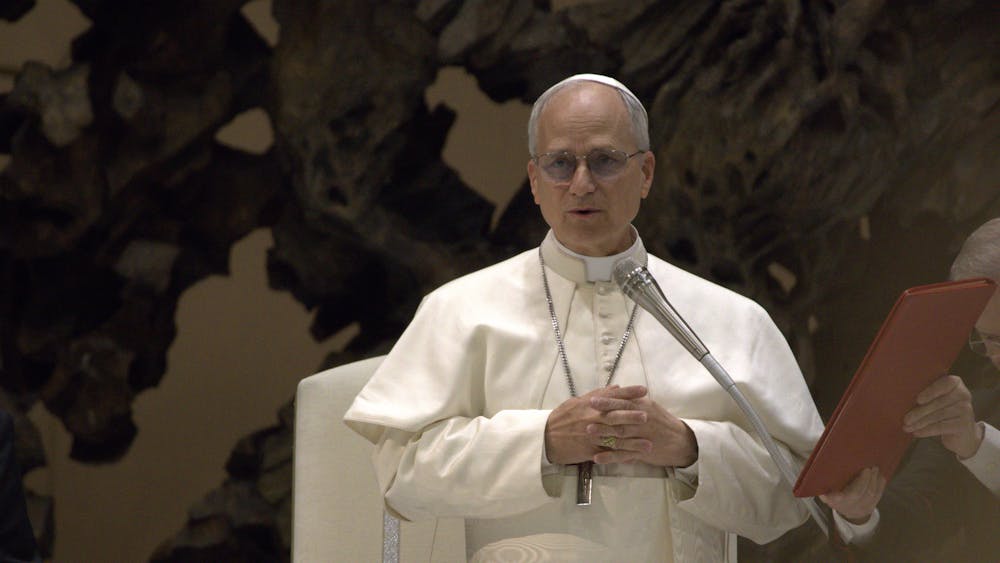For nearly 30 years, the Notre Dame Chorale has ushered in the holiday season with their performance of George Frideric Handel’s “Messiah,” a wildly popular Baroque masterpiece that tells the story of Christianity in three parts.
Music professor Alexander Blachly, director of the Chorale, described the piece as “indestructible.”
“That’s the word that people usually use about it,” Blachly said. “It means no matter how you perform, it is going to sound great. But I think it sounds a lot more great when it’s performed with this sense of style.”
When Blachly arrived at Notre Dame in 1993, the Chorale had significantly fewer members and performed “Messiah” with a full orchestra. For the past several years, however, the Chorale, which now has around 70 members, has performed with a small orchestra composed of 15 Baroque instruments. The distinctive sound of the Baroque orchestra, Blachly said, contributes to the “style” of the work.
“It’s clearer, it has a different kind of articulation, the notes speak in a different way,” Blachly said. “The sound of the orchestra is really quite light and the whole piece then has an agility to it. Many movements in Messiah are dances. It’s very hard to get a modern orchestra to dance. It sounds very heavy. ... Just by nature, the Baroque instruments have this quality of a kind of dance-like agility. It just makes the piece move so much faster and so much, much, much more interesting.”
Handel loved “Messiah” and directed it many times during his years in London, usually as a fundraiser for a charity or hospital. The passion, variety and drama of the piece, Blachly said, points to Handel’s inspiration.
“It sort of runs the gamut of what’s possible to make an interesting performance,” Blachly said. “... The piece is just full of these great contrasts and that’s part of what makes it such a great piece. You don't get bored because so many different things happen one after the other. It’s a very colorful conception that Handel had and he wrote it in this blind white heat. He wrote this whole piece in three weeks.”
The movements range from exuberant to gentle to powerful, Blachly noted, making for an interesting experience for the Chorale members as well. Senior Caiti Crahan, president of the Chorale, emphasized the unity of the work despite the differences in tone.
“Some of [the songs] are very serious and loud and some of them are more bouncy and some of them are very slow,” Crahan said. “So there [are] variations but it’s all him.”
In order to represent the full range of Handel’s expression, Blachly said the Chorale approaches the work “rhetorically.”
“We try to think what it was in the words that inspired Handel to write the music that particular way because in every case, he’s illustrating the words in one way or another,” Blachly said. “So once you're aware of that, then you try to figure out ‘what is it in his mind, what is he thinking of, what do those words suggest to him’ and then what is going on in the music that would correspond to the words.”
Blachly offered the interaction between the angels announcing Jesus’ birth and the shepherds on Christmas night as an example of Handel’s grasp on his composition.
“What happens with Handel is he’s got this incredible burst of sound with trumpets, when the angels first sing Glory to God,” Blachly said. “And then you can actually hear them going back up to heaven. You can hear them disappearing. The music is softer and softer and softer and softer ... and then they’re gone. You can literally hear the angels moving through the sky.”
Tapping into Handel’s mind in such a way gives the performance a richness that is not often seen, Blachly said.
“I think some performances are not particularly aware of these things and they really miss out on an opportunity to make the music more interesting because of that,” he said.
For Crahan, the Messiah tradition is one of the highlights of Chorale.
“The soloists are really talented. It’s kind of inspiring to see them perform,” Crahan said. “I think the part that I like best is that we do it every year so it feels like a very Christmas-y tradition and gets us all [in] the holiday mood. ... You can kind of hear yourself improving over the four years that you sing it, which is also really fun.”
“Messiah” is Chorale’s most popular performance of the year, Blachly said. Crahan described how the adrenaline of performing is heightened by having a larger audience than a typical Chorale performance.
“We have so much more energy and so much more fun when you can see an audience is engaged,” Crahan said. “When we sing the Hallelujah chorus, which is the last piece and the most famous one, obviously, everybody stands up which is so cool to see every year.”
Blachly pointed to the Chorale members’ talents and the adjustable acoustics of Leighton Concert Hall as major improvements to the tradition. The acoustics, Blachly said, allow the less powerful, but more “colorful” Baroque instruments to stand out.
“This is really satisfying because the choir is so good and the hall is so good and the orchestra so good,” Blachly said. “It’s just a great treat to do it. It’s really fun to do it and we can do it on very short notice; that’s the other thing that’s kind of incredible. When I started here, it was very slow going … now the learning curve is so fast. It’s just extraordinary.”
ND Chorale prepares traditional Christmas performance of Handel's ‘Messiah’
The Notre Dame Chorale performs Handel's “Messiah,” a Christmas tradition at the University, in Leighton Concert Hall.









